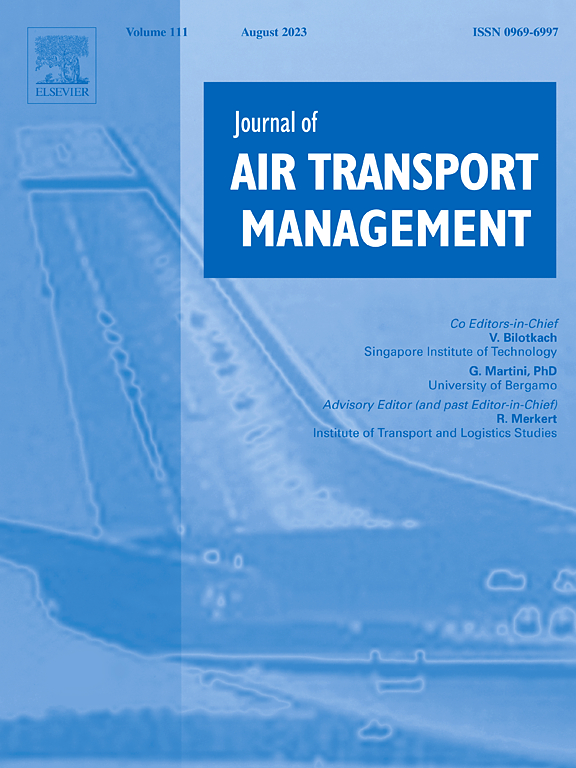超短程航线电动垂直起降飞机选择:模糊层次分析法
IF 3.6
2区 工程技术
Q2 TRANSPORTATION
引用次数: 0
摘要
20多年来,航空运输对环境影响的分析和认识一直受到学术界和工业界的关注。同样明显的是,近年来这种对环境的关注有所增长,尤其是超短途航班。鉴于一些欧盟国家最近出台了与超短程飞行禁令有关的新限制,以及电力推进技术的最新发展,电动垂直起降飞机(eVTOL)为航空公司重新获得这些航线提供了可能。考虑航线要求,结合电动新车的性能,本文的主要目标是选择新的eVTOL飞机,可以替代传统的飞机类型。该方法基于模糊层次分析法(FAHP)和对数模糊偏好规划(LFPP)相结合,从专家判断中确定优先级。分析考虑了六个候选evtol的操作和性能要求,通过多标准决策评估其适用性,并检查结果对标准权重变化的敏感性。为了说明eVTOL采用的实际潜力,分析了两条被禁止的欧洲航线。研究结果强调了将eVTOLs整合到短途网络中的机遇和局限性,并为未来可持续航空运输的研究提供了方向。此外,fahp衍生的解决方案在所有利益相关者群体中被一致确认为最合适的替代方案。本文章由计算机程序翻译,如有差异,请以英文原文为准。
Electric vertical take-off and landing aircraft selection for ultra-short-haul routes: fuzzy AHP approach
The analysis and understanding of the environmental effects of air transport has been attracting the attention of academia and the industry for more than 20 years. It is also evident that this environmental concern has grown in recent years, with a special focus on ultra-short-haul flights. In light of a new restriction recently introduced in some EU countries related to ultra-short-haul flight bans, and the recent developments in electric propulsion technologies, the electric vertical take-off and landing aircraft (eVTOL) offers a possibility for airlines to regain these routes. Considering the route requirements, together with the performance of electric new vehicles, the main objective of this paper is to select the new eVTOL aircraft, which could be exploited instead of conventional aircraft types. The proposed approach is based on the Fuzzy Analytic Hierarchy Process (FAHP) in combination with logarithmic fuzzy preference programming (LFPP) to derive priorities from expert judgments. The analysis considers operational and performance requirements for six eVTOLs candidate, evaluates their suitability through multi-criteria decision making, and examines how sensitive the results are to changes in the weighting of criteria. To illustrate the practical potential of eVTOL adoption, two banned European routes are analyzed. The findings highlight both the opportunities and limitations of integrating eVTOLs into short-haul networks and provide directions for future research in sustainable air transport. Additionally, the FAHP-derived solution, is consistently confirmed across all stakeholder groups as the most appropriate alternative.
求助全文
通过发布文献求助,成功后即可免费获取论文全文。
去求助
来源期刊

Journal of Air Transport Management
TRANSPORTATION-
CiteScore
12.40
自引率
11.70%
发文量
97
期刊介绍:
The Journal of Air Transport Management (JATM) sets out to address, through high quality research articles and authoritative commentary, the major economic, management and policy issues facing the air transport industry today. It offers practitioners and academics an international and dynamic forum for analysis and discussion of these issues, linking research and practice and stimulating interaction between the two. The refereed papers in the journal cover all the major sectors of the industry (airlines, airports, air traffic management) as well as related areas such as tourism management and logistics. Papers are blind reviewed, normally by two referees, chosen for their specialist knowledge. The journal provides independent, original and rigorous analysis in the areas of: • Policy, regulation and law • Strategy • Operations • Marketing • Economics and finance • Sustainability
 求助内容:
求助内容: 应助结果提醒方式:
应助结果提醒方式:


